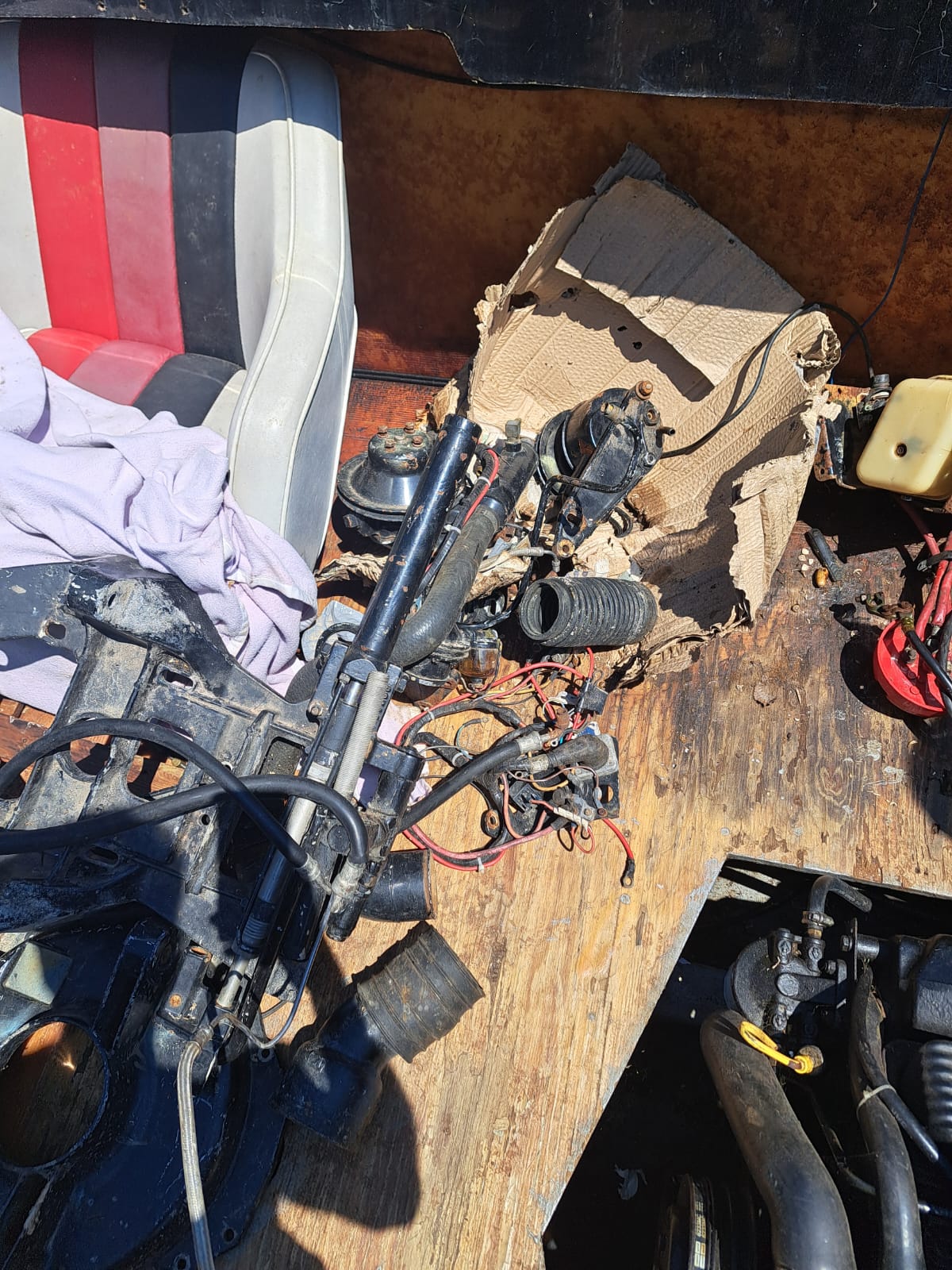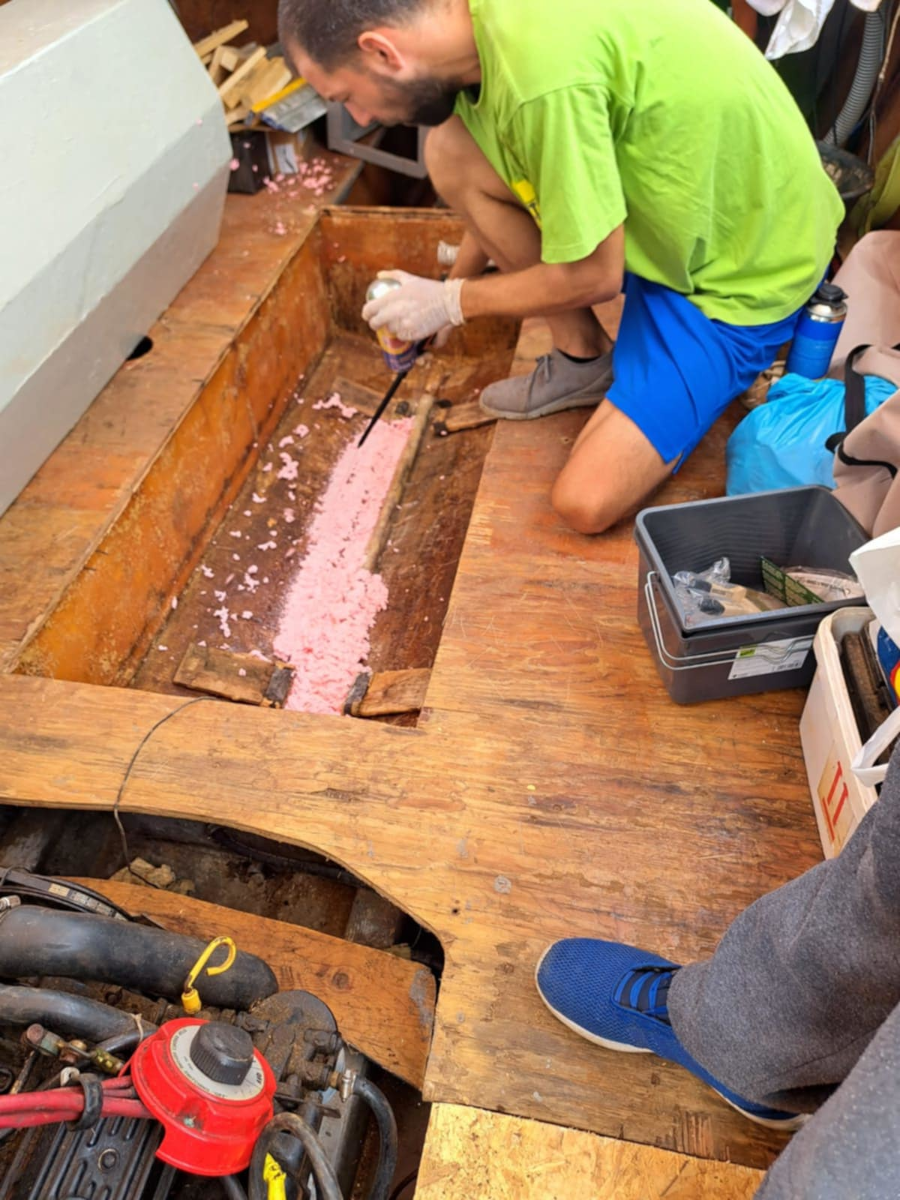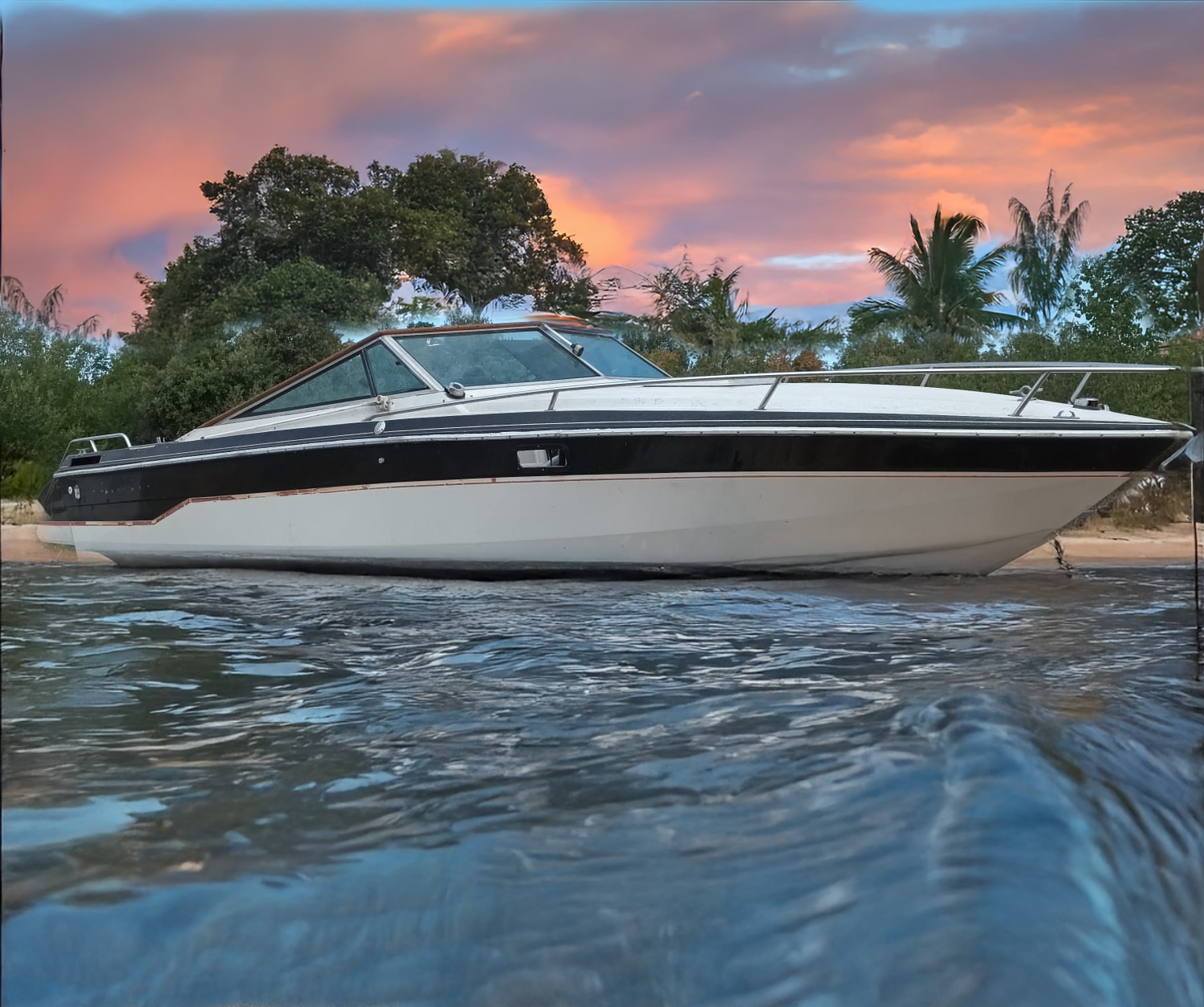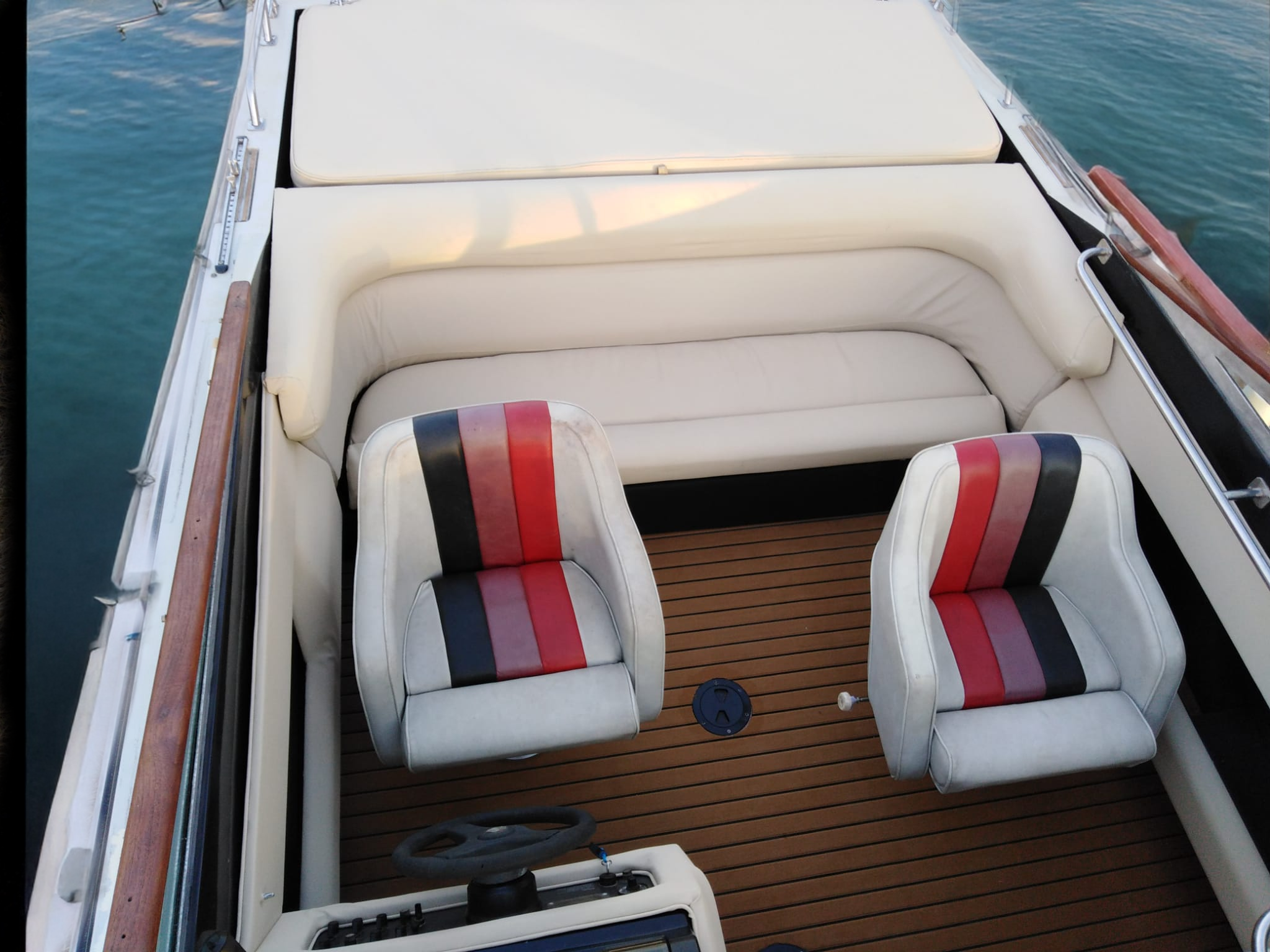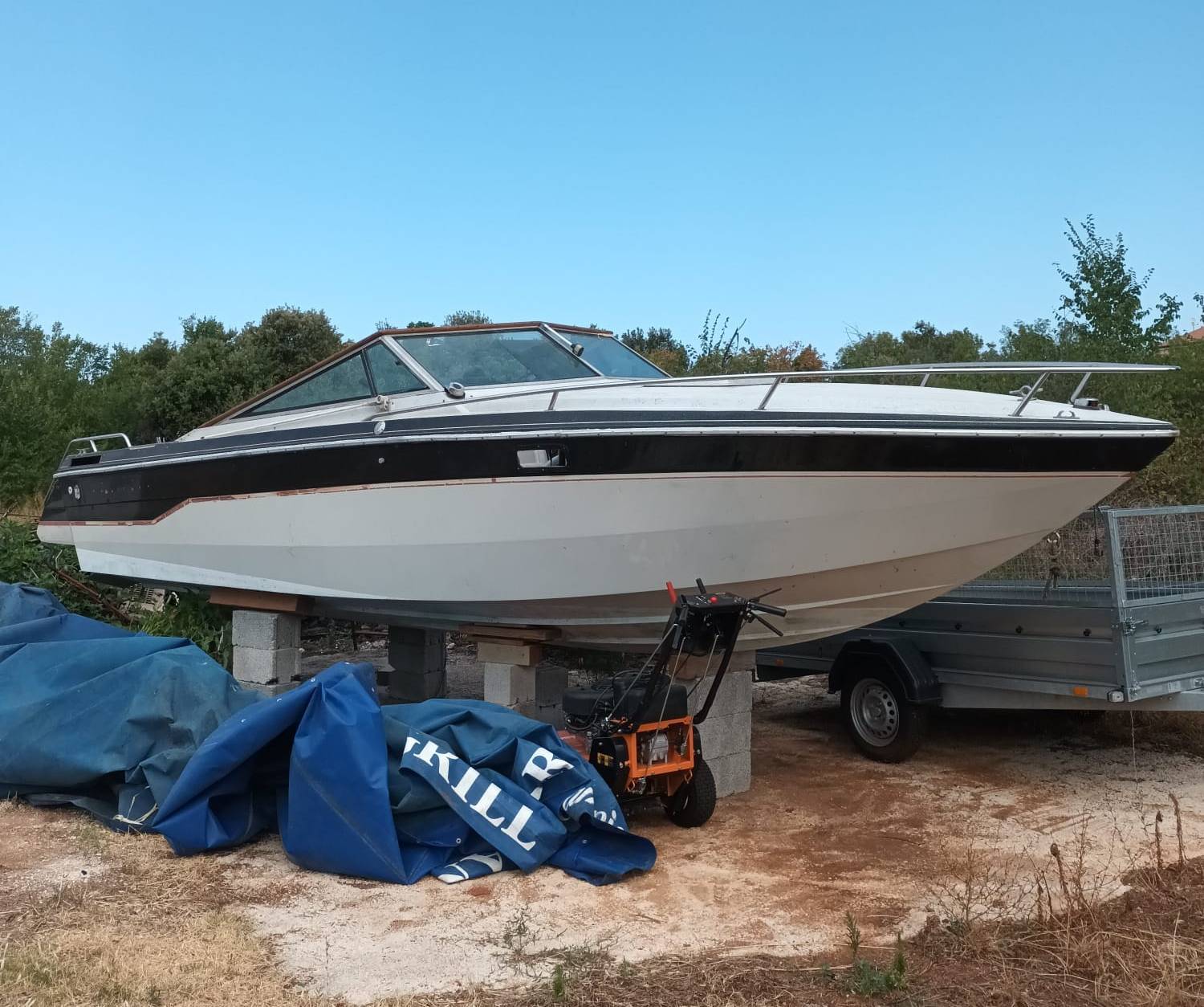A Story of restoring Chris Craft Scorpion 230 LTD
A Story of restoring Chris Craft Scorpion 230 LTD
Somewhere in the pine-shadowed edges of the Croatian coast, in a modest yard echoing with the sound of sanding paper and an old V8 sputtering back to life, a vision was born. Not from a textbook, not from a pitch deck but from calloused hands, childhood dreams, and a fierce, sometimes irrational love for boats that had long stopped being loved.
This is the story of SkipperCro CEO, a start-up of Boat Tours Pula and Boat Excursions Pula like no other. A project built not for profit margins or seasonal hits, but to bring back the soul of the sea through something many considered forgotten: American vintage speedboats. And not just any boats Chris Craft Scorpion 230 LTDs, iconic beasts of 1984s engineering that once ruled the waters like rebels with throttles.
But as with most great things, the journey didn’t begin with fanfare. It began with decay.
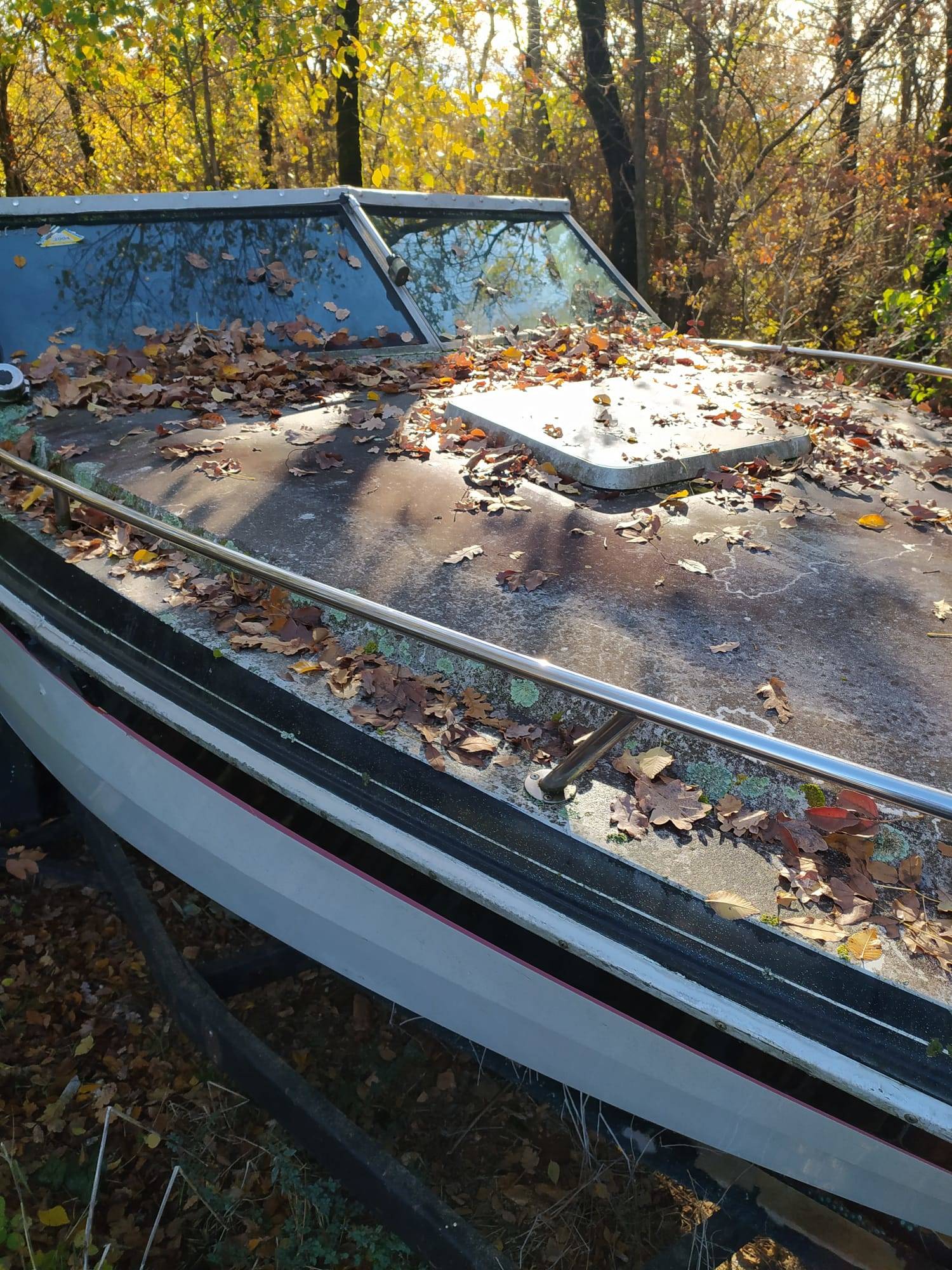
The Boat That Wasn’t Supposed to Float Again
When the first Scorpion 230 LTD was discovered, it wasn’t gliding across the Adriatic. It was decaying in silence tucked behind a fence, covered in vines, corrosion, and regret. Its once-proud aluminum fuel tank was leaking, foam soaked in gasoline fumes, the hull cracked from stress and salt. Most would’ve seen junk.
But for me as SkipperCro’s foundera licensed sea captain with nearly a decade on the water it was a calling. “Where others saw a wreck,” I recall, “I saw a story that wasn’t finished.”
I was working twelve-hour shifts at sea, navigating charters under the blazing sun. But when the last guest left the deck, the story didn’t pause. I would jump in the car, drive 14 miles under the Croatian sun sometimes in 40°C heat just to continue the resurrection. There were days when the only breeze I felt came from the oscillating fan in the dusty shed, nights spent under headlamp glow, soaked in sweat and resin.
This wasn’t a side project. It was a second life.
And what followed was a restoration epic.
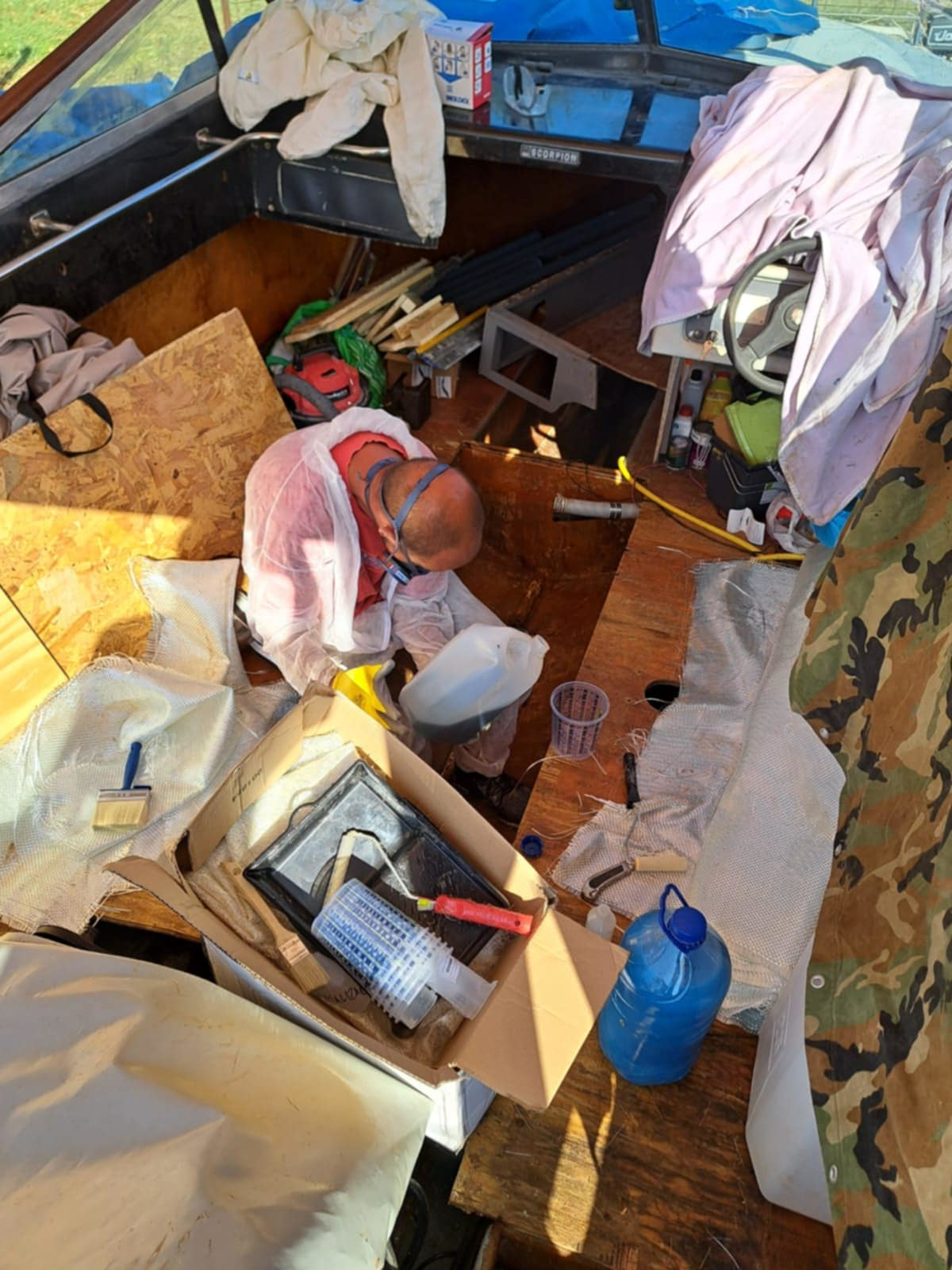
The Tank
The deck had to be cut open and not in haste. I remember crouching under the summer sun, grinder in hand, goggles fogged with sweat. Each pass of the blade threw sparks and dust into the air, but I kept cutting, layer by layer, until the shape of the old aluminum tank finally revealed itself, buried beneath rot, fiberglass, and years of silence. It looked like a fossil. Forgotten. Abandoned. Dead.
When I finally pulled it out, the smell hit me the sour stench of fuel-soaked foam. I knew it was bad. What I didn’t expect were 54 micro-holes scattered across the base of the tank. Most people any sane person would’ve thrown it away. Bought a new one. But I couldn’t. Not just because the cost of a new tank was over €3,000, but because that tank belonged to this boat. It was part of its story.
So I got to work.
I cleaned every inch of the corroded surface, sanding it gently until metal reappeared beneath the decay. Then, using marine-grade Liquid Metal epoxy, I began sealing each pinhole. One by one. Like a surgeon with a brush instead of a scalpel. It was maddeningly slow, but there was something therapeutic in it like I was speaking to the boat with every brushstroke:
You’re coming back.
When I finally sealed the last hole, I coated the whole surface and left it to cure. The next day, I placed the tank back but this time I cradled it inside a wall of fire-retardant foam, locking it safely into its compartment. Not because regulations told me to, but because I knew what would be sitting above it: people. And I wanted to sleep at night knowing I did everything I could to protect them.
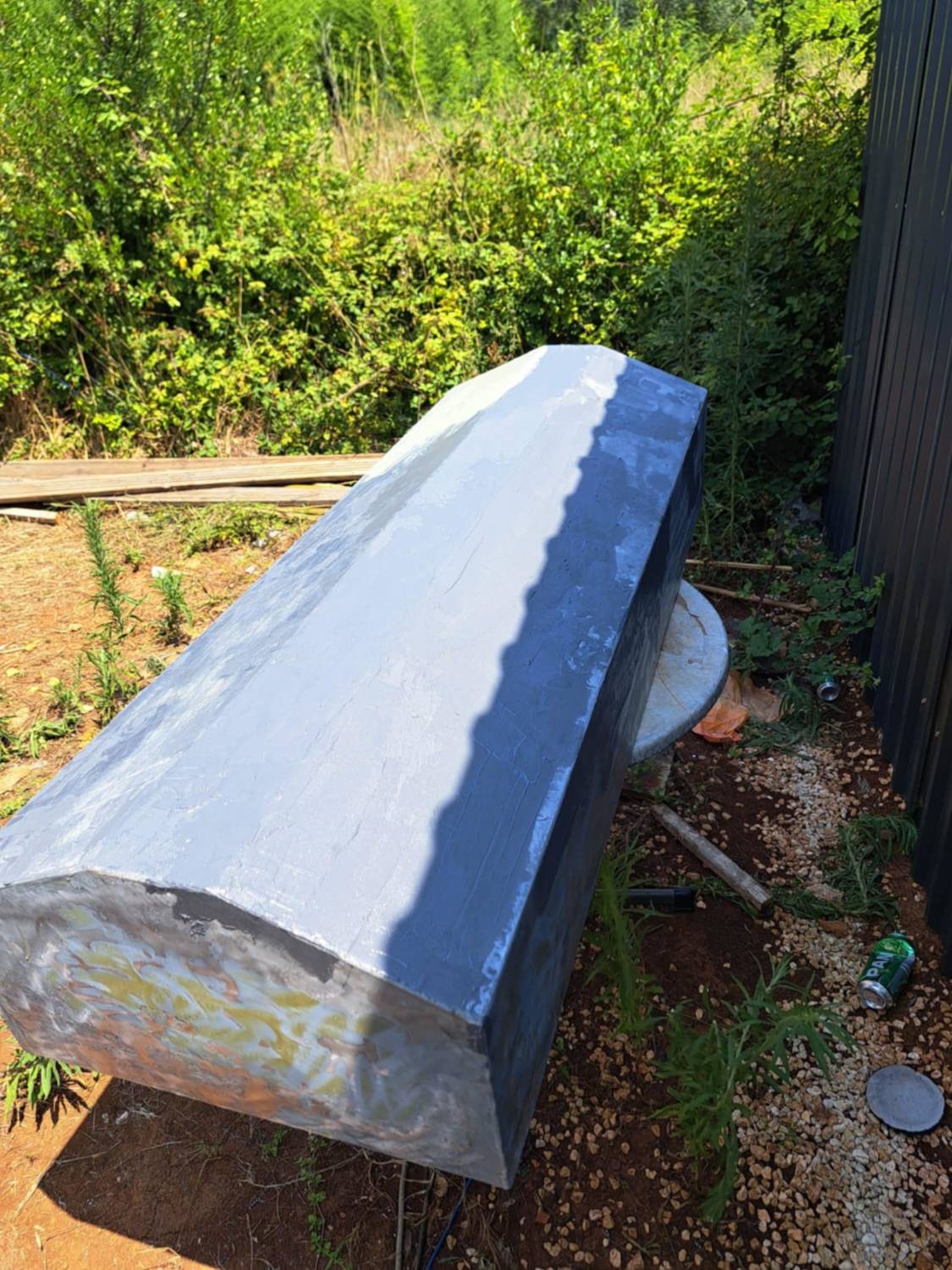
The Engine
They say the engine is the heart of the boat. If that’s true, mine had flatlined. Read entire step by step guide how to Restore Chrirs Craft Scorpion 230 tank.
It was a MerCruiser 5.7L small block V8, rusted into silence, locked with salt, time, and corrosion. I called a mechanic for a quote just to see what I was dealing with.
“€10,000, just for the work,” he said.
I laughed. Not because it was funny, but because I had two options: give up, or do it myself.
I chose the second.
I spent nights studying diagrams, searching forums, watching MerCruiser disassemblies on YouTube, even feeding questions into ChatGPT until I could start drawing the system in my sleep. Then I picked up a wrench.
First came the cooling intakes both sides were corroded beyond use. I ordered replacements for €1,100, then unbolted the crusted originals and installed the new ones.
While tightening the bolts, I noticed the water pump bearing was oscillating nearly half a centimeter enough to cause the “click-click-click” that haunted me on every crank. Out it went.
Then came the ICU the boat’s brain. It was giving off false positives, making the engine shut down randomly. When I pulled it out, I could see corrosion biting into its core. I replaced it for €200.
With everything cleaned, replaced, or reinstalled, I lowered the engine back into the boat. Wired it. Secured it. Connected a water intake pipe for testing.
And then ignition.
The engine started. The roar of that Chevy V8 was like music. For three seconds, I was in heaven.
Until I saw water pooling in the engine bay.
My heart sank.
I turned everything off, traced the flow, and finally found the cause the cast iron double exhaust outtake had cracked under pressure. This wasn’t a part you could find in any shop. It was an American part from 1986. Not something stocked in Croatian marinas.
I spent days scouring the web, calling suppliers, begging for quotes. Eventually, I found one €1,300, shipped from the U.S. I ordered it immediately.
When it arrived, I held it like a sacred object. I installed it the same day, bolted it in, sealed every connection, ran the test again...
And this time, no water.
The engine roared. The compartment stayed dry. And I just stood there, oily, exhausted, and grinning like a lunatic because she was alive again.
The Outdrive
I knew going in that the Alpha One outdrive would be trouble.
This isn’t some modern outboard you can plug into diagnostics or swap out modularly. This is old-school. Pure mechanical guts bearings, shafts, gears, and decades of vibration and corrosion packed into one heavy unit bolted to the transom.
I started slow. I had to. Every bolt threatened to shear, every gasket had turned to brittle powder. It took me four days to carefully dismantle it without damaging the inner workings. My hands were stained with old oil and grease, knuckles skinned from slips, tools sliding across the metal like nervous scalpels.
Inside, the bearings were shot pitted and loose. I replaced them all, step by step, tightening everything with measured force. €300 in parts, and just as much in patience.
I thought it was done.
But when I fired up the engine for a dry-run test, I noticed something was off. The engine sounded right. But it wasn’t pulling water from the sea leg. The cooling system wasn’t working.
So I tore it down again.
This time I went deeper all the way to the lower unit, the bottom of the drive leg where the impeller lives. And there it was.
Melted. Warped. Useless.
The impeller had disintegrated from heat. Around it, the intake passages were blocked by dead insects, dirt, and salt-crusted debris. The shaft itself was corroded, flaking and swollen, barely recognizable.
I stood there for a moment greasy, tired, heart sinking.
But giving up wasn’t an option.
I sourced a new impeller kit, a new shaft, and new seals. I cleaned the entire intake system, scraping it gently with dental picks and soft brushes so I wouldn’t scar the interior. Reassembled everything. Two more days just for this step.
€900 gone, but this time, I knew it was right.
When I finally bolted it all back and started the system, it purred. A deep, throaty, even rumble from the V8. And this time, I saw the water gushing through perfectly. The cooling system was alive.
I didn’t cheer.
I just sat down, tools still in hand, looked at the boat and smiled.
“The roar of that mercruiser 250 V8 was like a thank-you.”
The Seatings
Let me be clear I’d never sewn a thing in my life. Not even a button.
But when I went looking for factory replacements for the Scorpion’s seatings, I found two things: outrageous prices, and zero soul.
Generic patterns. Cheap foam. Materials that looked plastic under sun. They would’ve killed the vibe I was trying to build.
So I made a decision that sounded absolutely crazy at the time:
I’ll sew it myself.
I bought a sewing machine. Watched videos. Burnt through meters of scrap fabric. My hands cramped from threading, unthreading, stitching again. I broke needles. Swore. Ripped apart a seat I’d spent a full day on because it wasn’t right.
But after ten days and €950 in premium marine-grade leather and UV-stable fabrics, I made it.
Hand-sewn, custom-fitted seatings, shaped to the boat’s original lines, hugging the fiberglass curves like they were born there. The feel was perfect. Supple, firm, resilient. I ran my hand across them and felt something I hadn’t before:
Pride.
“I’ve never sewn before. But when something deserves love, you learn.”
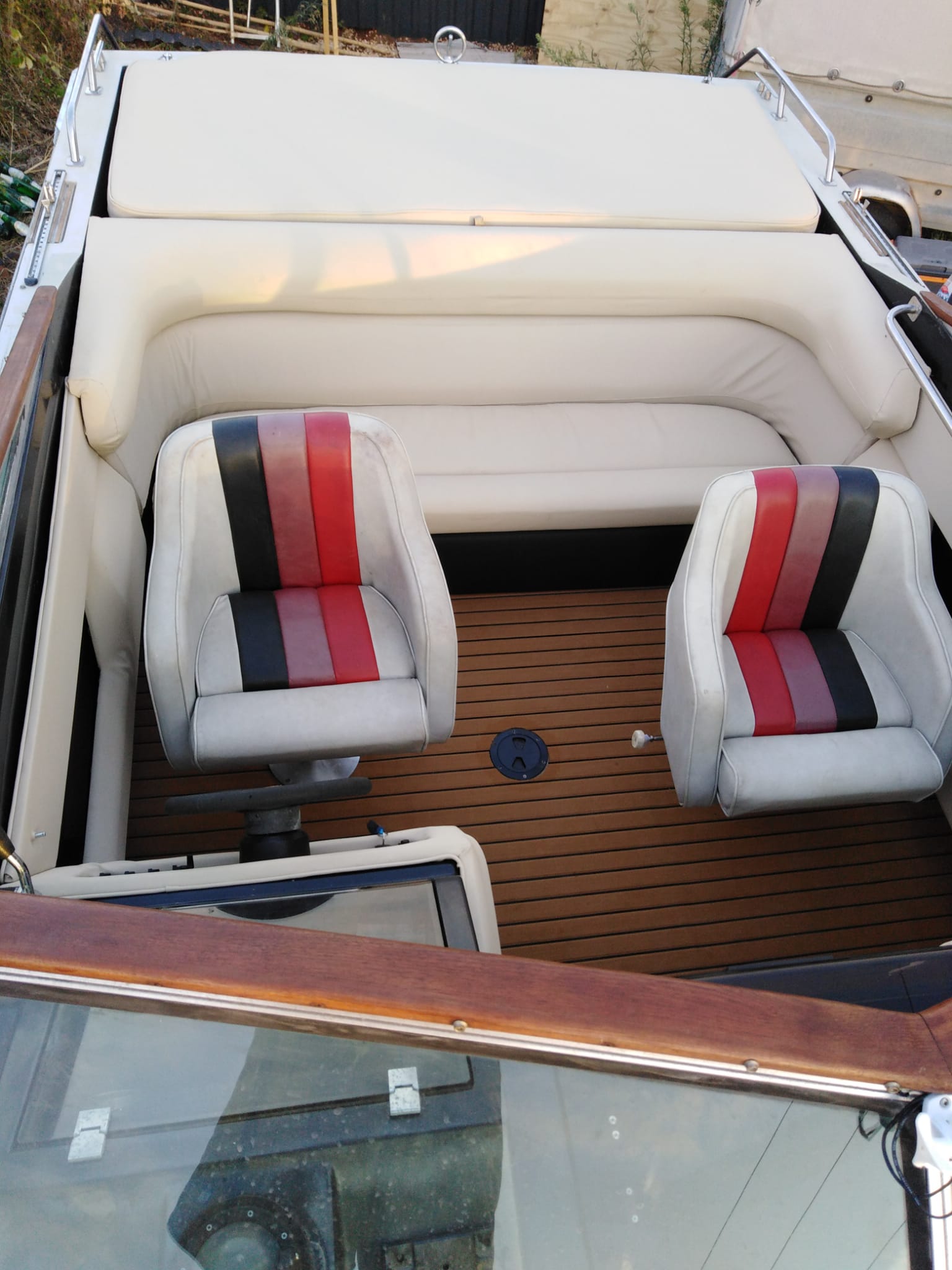
The Cockpit
With the mechanical systems done, I turned to the soul of the experience: the cockpit.
No one rides in the engine. They ride in what they feel.
And I wanted them to feel everything the speed, the sound, the soul of this resurrected legend. So I needed the interior to match the power below.
I had already hand-sewn the seatings (more on that in a moment), but now came the assembly. Custom-mounting the covers, re-fitting the instrument panels, measuring console angles. All of it needed to be precise the kind of precise that doesn’t come from schematics but from standing back, squinting at the lines, adjusting by instinct.
It took me five days of trimming, re-bolting, remounting.
I had to redo some of it because good wasn’t good enough. It needed to feel like home. Like something you stepped into and felt transported, like you’d always belonged there.
Now, when I step in barefoot and grip the leather wheel, it doesn’t feel restored.
It feels reborn.
70% There, But the Finish Line Still Needs to Shine
Right now, the boat is alive.
She moves. She breathes. The engine turns over with that signature V8 growl, the same one that once tore across the American lakes and is now reborn for the Adriatic. The cockpit is fitted, the new handcrafted seatings are in place, the systems are functional.
We’ve made it through the storms of rust, corrosion, rewiring, fiberglassing, lifting, cutting, sewing, and soul-searching. And now, now comes the final 30%.
And it’s maybe the most symbolic part of the entire build.
The Paint, A Ritual, Not Just a Coat
It’s not just about color. Not just about “making it look nice.”
This is the skin. The identity. The part that catches the sun, reflects the water, and lets the world know she’s not just restored she’s proud of it.
I’ve decided to go for a full high-gloss finish, the kind you rarely see on these waters. Why? Because Route 66 didn’t roll through the desert in matte grey. It roared. It gleamed. It celebrated the road, the journey, the machine.
That’s what this hull will do.
But this kind of shine doesn’t come easy. It takes layer after layer, each one polished and sanded down, then buffed back up, then repolished. Circular motions. Hours at a time. Breathing in dust, feeling every pass of the buffer in my shoulder blades. Two full working weeks minimum.
I’ll do it by hand. I could pay someone, but it wouldn’t feel right.
And once she gleams, I’ll be placing the finishing touch: Route 66-inspired detailing and the official SkipperCro emblem. The story we’ve been writing in sweat and stitches will finally wear its own title on the water.
The Cabin, A Home Under the Bow
Next comes the cuddy cabin, tucked under the sleek nose of the Scorpion.
Right now, it’s just a hollow space, echoing with potential. But soon, it will be a sanctuary, not luxurious, not grand, but warm, intentional, alive. The kind of place you crawl into after a long tour, still buzzing from adrenaline, and rest your head against leather that smells of sea and engine oil.
I’m planning to fully insulate it, line the walls in a mix of marine leather and fabric, build two narrow beds for resting, install soft LED strips for mood light, and maybe ust maybe add a mini archive of old nautical maps and stories in the corners.
This isn’t just upholstery. It’s storytelling in space.
It will take me at least one month of precise sewing, woodwork, cutting, and mounting. The material cost alone is around €3,500 and that’s before I even count in my hours.
But I’m not counting hours anymore. I stopped doing that when I realized that this isn’t work. It’s devotion.
Help Finish What Was Started — And Reserve Your Ride Into the Story
This boat isn't just being restored so I can say "look what I built."
It’s being restored so you — yes, you — can ride it.
So you can sit in those hand-stitched seats, feel the V8 growl under your feet, grip the rail as we cut across open sea, and be part of something alive.
Right now, we’re 70% done. She floats. She roars. But she’s not finished.
And every tour seat pre-booked now through our crowdfund isn’t just a reservation. It’s a brush stroke on the hull. It’s a bolt in the engine. It’s polish on the story.
It’s your name written into this movement.
Your early booking doesn’t go to some holding account. It goes directly into the restoration — into the high-gloss paint, the cabin build, the materials for Boat #2, and the foundation of something much bigger.
It goes into reviving more old legends. Into building a fleet. Into keeping the spirit of Route 66 not just on the road, but now also on the sea.
And if you can’t ride with us—maybe because of distance, or time, or life—
you can still support the project in the most powerful way we’ve seen:
Donate So Others Can Go
In our previous campaign, we opened up spots for those who could never afford this kind of experience—students, adventurers, families in tough times.
And you helped us do that.
It wasn’t charity. It was solidarity.
Because when you give someone a ride on a restored old-timer, you’re not just giving them a tour.
You’re giving them perspective. You’re giving them a story.
So here’s the ask, plain and true:
- If this project stirs something in you — book your tour now. Ride the boat you helped complete.
- If you believe in restoring heritage, donate to help us finish this boat — and start the next.
- If you believe in giving back, sponsor a ride for someone who needs it more than you do.
This isn’t a sales funnel.
It’s an open invitation.
Let’s build this together — wave by wave.
→ Pre-Book Your Tour (via Crowdfund)
→ Donate So Others Can Go
Aljosa
.


